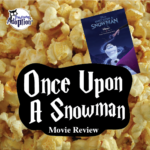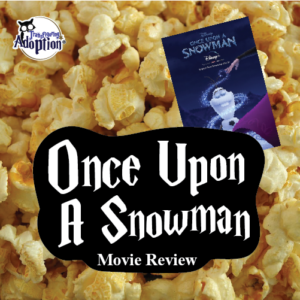
Once Upon a Snowman (2020)
Grade:
Transfiguring Adoption awarded this movie 5 Hoots out of 5 based on how useful it will be for a foster/adoptive family. [Learn more about our Hoot grading system here]
Movie Info:
- Rating: PG
- Genre: Coming of Age, Family, Comedy, Fantasy, Animation
- Runtime: 12 minutes
- Studio: Disney/Pixar
From the Cover of Once Upon a Snowman by Disney/Pixar:
“The previously untold origins of Olaf, the summer-loving snowman who melted hearts in the Academy Award-winning 2013 Disney animated feature, Frozen, and its acclaimed 2019 sequel, are revealed in the all-new Walt Disney Animation Studios animated short, Once Upon a Snowman. The film follows Olaf’s first steps as he comes to life and searches for his identity in the mountains outside Arendelle.”
Transfiguring Adoption’s Overview:
The target audience for the short film Once Upon a Snowman (2020) appears to be children aged 3 and up. It also appears this movie would be best for any family wishing to revisit the world of Arendelle. This short film may be relatable especially to foster or adoptive children due to feeling a sense of missing identity when separated from their family of origin, as Olaf feels once separated from Queen Anna mid-transformation.
** Spoilers Could Be Ahead **
How Is This Relevant To Adoption & Foster Care?
Once Upon a Snowman (2020) shows us the origin story of Olaf and gives us the answers to what happened to him between the time that Queen Elsa reanimates him and when he meets up with Princess Anna, Kristoff, and Sven. While Olaf may not himself be a foster or adoptive child, he is a newly summoned creature that does not know his own name or who he is and wishes to find his purpose.
Through the very short film we see Olaf remember his name, discover the beauty of summer, and remember that he loves warm hugs. While this is a very short film this can be a wonderful medium to help children talk about the feelings of loss and confusion they may feel during transitions and trying to figure out who they are in all of the change.
Discussion Points:
- Identity
This is a fairly short film at less than 12 minutes of actual film screen time so I will only focus on Olaf’s mission to discover his identity. Like many children from the child welfare system, Olaf (literally) transitions several places in a small space of time and interacts with the people, animals, and objects he comes across on this brief journey. Children who have endured trauma may suffer a loss of identity when separated from their family of origin, culture, friends, and all of the other things that are familiar and, like Olaf, may need some time and guidance to reorient themselves with their new normal and how to best move forward. This illustration from Olaf can help us talk to children about these shifts and discoveries in identity.
Cautionary Points:
- Fantasy Violence
Olaf doesn’t suffer irreparable harm throughout the short film but he does have some accidents and brushes with violence. He is knocked off a mountain by Queen Elsa’s cape, has a door slammed on him, is chased by wolves, falls off mountains a few more times, and is nearly injured in a sleigh wreck and explosion. Olaf is able to piece himself back together and move on, but this may be a trigger for children who have endured trauma and have over-stimulated stress responses. - Inappropriate Humor
Olaf makes a joke about the shop’s name “Wandering Oaken” being an anagram for “Naked Norwegians”. He also for a moment has a toilet plunger for a nose. While the anagram joke may fly over most kids’ heads they will definitely notice the word “naked” being uttered and some children may try to emulate the joke for a reaction. There may also be potty-humor talk as a result of the plunger used for a substitute nose. - Gets Lost In Woods
While Olaf is not a literal child, he is a child-like character who is lost and confused in the woods. Olaf even expresses this verbally while wandering alone in the dark woods. Though this likely won’t trigger most children, if a child has had a traumatic experience with getting lost in the dark or in the woods this may be problematic and something to watch out for.
Discussion Guide:
- Why do you think Olaf doesn’t remember his name or who he is?
Caregiver Note: With this question we can get the conversation started about the movie before moving into tougher questions. You may discuss how Olaf wasn’t finished transforming when Queen Elsa’s cape knocked him off the mountain. It also could be because Olaf fell and hit his head. And it could just be how Queen Elsa’s magic works. - When Olaf is lost he approaches the shopkeeper. Who else could have been safe adults for Olaf to look to for help?
Caregiver Note: Sometimes children who have been raised in the midst of trauma are not taught things like “stranger danger” or how to identify safe adults. As a result, they could potentially find themselves in unsafe places if not given this lesson. Take this as an opportunity to discuss safe adults they can approach if they are ever lost or scared like a police officer, doctor, nurse, teacher, store clerk in a store, or caregivers. - How does Olaf realize he likes summer so much? Did he figure that out on his own?
Caregiver Note: Sometimes we may come to realizations about ourselves through experiences we have alone while others come with the help of others. As a snowman, Olaf would never have experienced summer himself as he would melt at this point in the timeline. But, thanks to Oaken’s viewfinder Olaf is able to see different pictures of all the beautiful things that come out in summer. This is a good way to talk about trying new things with a safe adult or friend and how we may come to like things we never thought we’d try! - What does Olaf learn through wearing a summer sausage as a nose in the woods? How can you learn from mistakes like Olaf?
Caregiver Note: Sometimes adults are so caught up in making sure children don’t make mistakes it’s easy to forget how much growth can happen when natural consequences come from a mistake. We see very quickly that Olaf did not know that wolves like meat, so when he skipped into the woods with his sausage nose he was in for the chase of his life! While this was comical for us, poor Olaf does not find this amusing and is put at a large risk. However, with this new knowledge Olaf is able to select a more appropriate nose (a carrot) later. Talk to your child about learning from mistakes and remembering them to make better choices later. - After the chase, Olaf recognizes the wolf needs the sausage more than he does and gives it to the wolf. He then says that the wolf’s licks feel like a warm hug and remembers that he loves warm hugs. How can you help others to learn more about yourself?
Caregiver Note: One way we can learn about ourselves and grow is to help others in need. Talk to your child about different ways we can feel “warm hugs” by helping others by volunteering time, being a listening ear, or giving a warm hug with consent to comfort someone that is sad. Our identity can be more than our name and what we like and can also include what we do with our actions and talents. - ACTIVITY: The Nose Knows?
Caregiver Note: This is a silly activity that can help with bonding and laughing together, which is important for connecting with your child. I came up with this idea watching Olaf react to having a sausage scented nose. We’d rather our kids not wear food like Olaf, so let’s practice with our sense of smells. Gather together 5 things with distinct smells. I’d start with some summer sausage, a cheese your child likes, some ranch dressing, cut apples, and something like peanut butter. Substitute foods to accommodate any allergies. Place each of these foods in a solid box that cannot be seen through and have an opening to be able to smell the food. Take turns with your children and guess what each item smells like. Whoever gets the most gets to pick dinner one night that week. Afterwards enjoy your snack together and talk about the short film now that you have loosened up with some fun.
You don’t have to use food and can use any combination of items but overall this one will get you all laughing fast!
NOTE: Inclusion on these lists does not necessarily mean endorsement. Furthermore, with all our resources, we highly recommend you preview them first to determine if there are any trauma triggers that your child may not be ready to handle. Transfiguring Adoption does not intend for its reviewers nor its reviews to be professional, medical or legal advice. These reviews and discussion guides are intended to help parents to better be able to connect and understand their children who come from traumatic backgrounds.
